Kunda trip.
On the 28th to 29th of April.
Day 2.
The map below has the route I would walk on day two in Kunda. Leaving the cottage I stayed in by Hiiemägi, walking south to the Lammasmägi site for the installation, and walking back North to Kunda to catch the bus to Rakvere and then the train home.
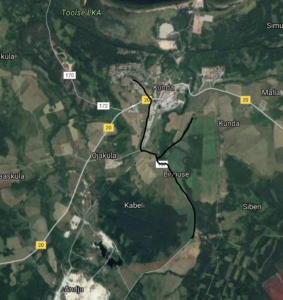
This map shows the total route walked over the two days and the destinations in circles.

The evening spent in the cottage was peaceful. My legs were a little wobbly when I first got there, but after some rice and beans, some 80s hits played on the old cd player and a sleep I was ready.
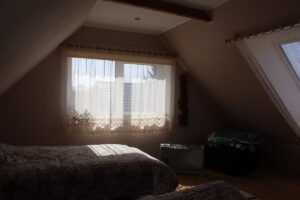

A short way from the cottage there was a bridge crossing the Kunda river. After crossing I noticed some structure built into the side of the river that was catching clay, so headed down a short track. At the bottom there was an old mill, with the water trap to divert the river under the mill building. There were also several other buildings around this one, and a smaller bridge made over the river.


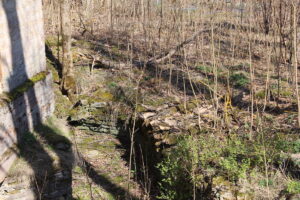
On the stone above it can be seen where the turquoise of the clay has stained them.

This above is the beginning of the channel that diverts the Kunda River water. If looked at closely, at the edge where the channel meets the river there is a pile of Kunda clay. It must be building up in this catch as it is carried in the water and pushed up from the banks.
This clearly happens a lot and a farmer has moved a massive pile of the clay out of this trap.
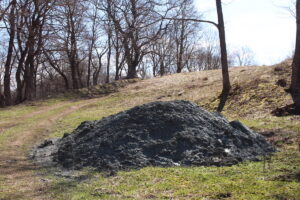
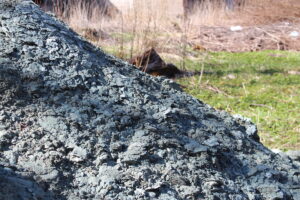
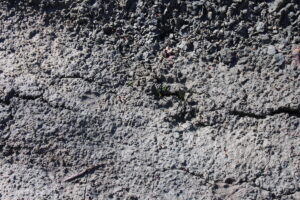
A deer footprint had been left in the clay.
The pile of clay was amazing. Gathered by the river and the ruins of its industry. It’s colour is something else.
This place has been created to work with the river and harness it’s energy. It is made clear the scale that can be produced by the resource of the power within the movement of water. I had felt the need to find a place along the river to film it on my trip. Walking in the landscape of Kunda the river is always winding through. The river and its water has a presence. And so I took some still takes of the moving water here.
Exploring the mill buildings I could see the old mill stones still there, and the shoots, and the worn away steps on the stairs from many feet up and down.
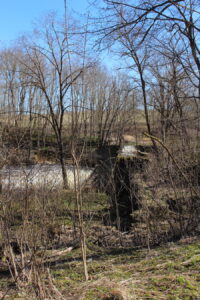
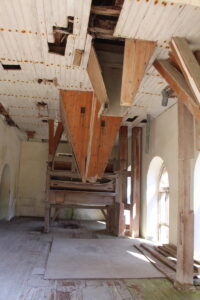
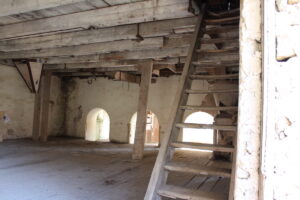
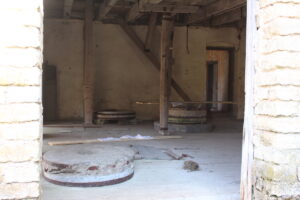
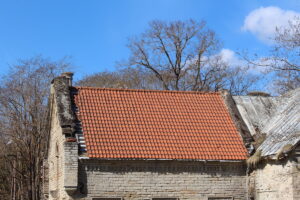

The structure here of the shed on top of the storage silos is one that is repeated on the giant Kunda cement factory. I photographed the concrete one when on top of Hiiemägi. It was interesting to see this structure repeated in two different places, from two ages, when things were moving from way of industry to another, in the same place, next to the same waterway.
After this mill there were so many big old derelict manor houses. This area of the mill must have had a sophisticated population, and a whole community. Now with only a few residents, with guard dogs. The big heavy garden walls leaning to one side, bulging, as if weighed down. There were walled gardens here at one time. It is common to see massive grand buildings derelict in Estonia, and much of the countryside houses have been left to be empty, however definitely not all.
The Kunda Cement factory was powered by hydro-electricity since it’s opening in the 1870s. The force of the river has been used for electricity since the beginning of industry in Kunda. The mining took place using steam engine powered machines. The hydro-electric plant in Kunda was the first of it’s kind in the whole of Estonia.

The national flower of Estonia, which is this blue purple one, that opens up into a star, slightly like a blue bell when closed, was out everywhere.
Continuing out of this forested nook of the river I came out onto the flatlands. The hot sun was blazing, but the cold wind was still whipping across. There are areas of woods, but for most of my day I was out and exposed on these roads, hoping for the small mound of Lammasmägi in the distance. The site is not on google maps but I managed to ask a local, and they told me to keep walking for 2km. The roads are so open, only seeing a few people, one keeping to his bees, it felt so good to be in the sunshine.
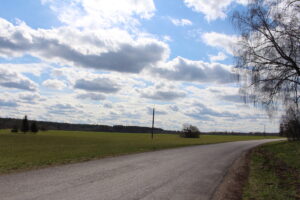
By early afternoon I had made it. I think I have developed a relationship to these places in Kunda in my mind, I felt an attachment to them, I was so happy to have found this small sloping hill that I have been studying and thinking and imagining so much about. It was not an obvious or easy trip, I didn’t know that I was definitely going to be able to find these places and successfully get there and film and find my way back.
So to see its raised form just peaking up from the fields was lovely.
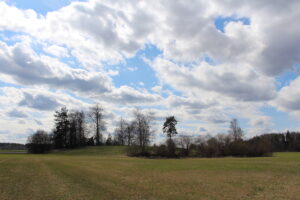
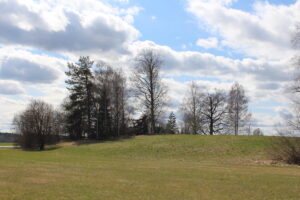
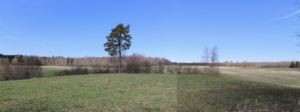
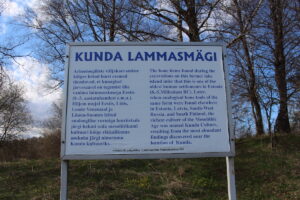
I enjoyed how articulate this sign was.

From the top of the hill I could see the Kunda cement factory in the distance. The silver birches next to the island were shining in the sun. And this small shed was quintessentially Estonian. Sitting on top of Lammasmägi I could even more so than on Hiiemägi feel the presence of the water. The flat fields still made it very easy to imagine this place as an island. There was evidence of a campfire on the hill and I was thinking about the stories they could tell, and how the kids’ imaginations could run wild, being on a piece of land with a form like this, and real stories, real carved bone pieces found. It must be the best place for storytelling.

On Lammasmägi, in the cleared area, there was a single tall Scots Pine tree. It must have been deliberately planted in the clearing, maybe 20 years ago. I began to look around the place to see where I should leave my sculpture. I walked down the slopes to the flat fields, walked around the old island on the flat fields, I didn’t feel scared at all at that place. I was alone, somewhere I didn’t know, but I felt so comfortable. On Hiiemägi the wilderness of the moorland, and the sounds of the scraping twigs on the trees spooked me slightly every now and then, and the thought of how many deer or other animals must come up there in evening. But at Lammasmägi I was ready and calm. I enjoyed even walking down the slopes of the hill, being able to feel the gradient through my bodies reaction to it, how steep or shallow it was. I have rarely felt such a fascination and curiosity for a specific hill.
There are beautifully rounded hills in Galloway, where I am from. I have not seen hills that roll like that anywhere else. You can’t even paint them, I tried and it doesn’t do them justice. There was one hill by my primary school, that we would roll eggs down at easter, and climb up sometimes. It felt so big then, to stand on the top of it when you’re small. There is a place above Otley in Yorkshire called surprise view. This is on the moor that looks over Otley at its edge. My family are from Yorkshire, and many live there. My grandma’s ashes were left by a small silver birch tree on surprise view. The tree’s still growing. These two hills or slopes I feel the same kind of feeling for, I suppose I have a relationship to them. You would think that a hill was permanent, something you could always rely on to stay and hold memories. In most cases this is probably true, but it is too that hills can be removed from the face of the earth by mining. Swiped away and distributed into everything else.
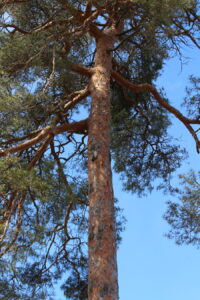
I concluded that by the scots pine would be the only correct place to leave the sculpture. There was a freshly dug mole hill right by it’s base, so I would dig this up, as it is already disturbed earth, and leave the piece there.

After installing I walked away. It felt nice to have left the box of Kunda clay with its small island lump inside in the earth of Lammasmägi. I thought about the empty space that the lidded box held within it, that was now existing under and within the earth of the old island, for however long before it dissolves and collapses in on itself. On the way back to Kunda town I crossed the old rail tracks that led out of the cement factory, as I neared closer I began to see the debris of the factory, and also a lot of empty vodka bottles tossed out of cars. There were some allotments right under a big windmill, with green houses and another a self-constructed bee-hive from corrugated tin. I could feel that my feet definitely had a few blisters, and I felt that Kunda was even more to me than what it was before. This time I really understood it. I caught the bus, the bus driver seemed very happy to see me, which is very unusual, maybe they had heard about the wondering person with the tripod, or maybe I just looked like I’d been on quite the journey. The skies were sterling blue all of this second day. I realised when exposed in the open that if there had been any rain it would have been hellish. I got off of the bus at Rakvere and tried to walk around town a bit before the train but it became quite apparent that my feet and legs were not too happy about that.
I caught the train, there were quite a few fast asleep army troops, the train comes from Narva and passes through Tapa which has a large army base, so this wasn’t surprising. Back in Tallinn I felt that I could see where I was clearer. The countryside is what Estonia is, the people are known for being close to nature, and of the forest. It was clear to me then that the people come to work in the city but their heart is always in the countryside.

